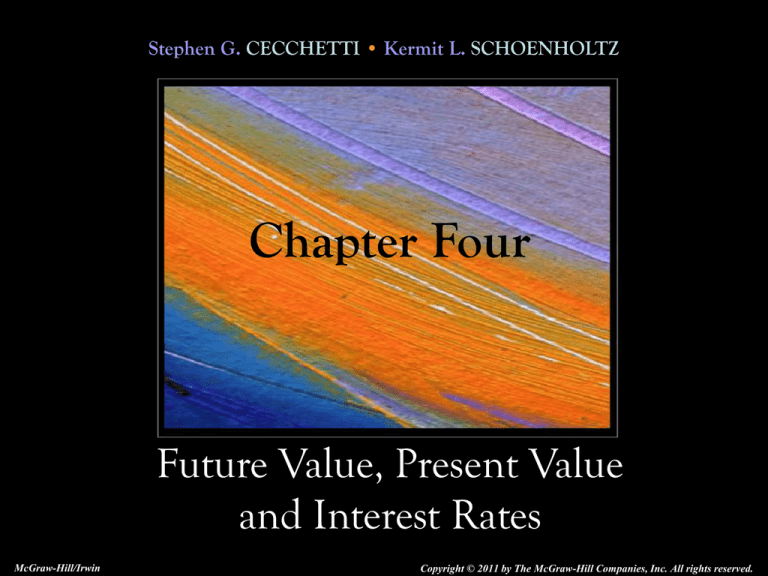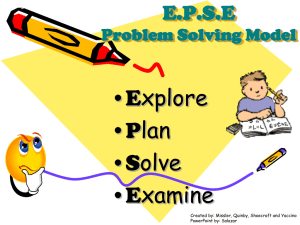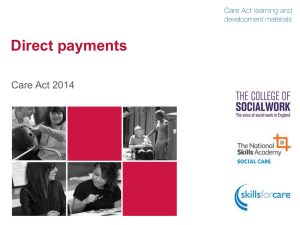
Stephen G. CECCHETTI • Kermit L. SCHOENHOLTZ
Chapter Four
Future Value, Present Value
and Interest Rates
McGraw-Hill/Irwin
Copyright © 2011 by The McGraw-Hill Companies, Inc. All rights reserved.
A Brief History of Lending
• Lenders have been despised throughout history.
• Credit is so basic that we find evidence of
loans going back five thousand years.
• It is hard to imagine an economy without it.
• Yet, people still take a dim view of lenders
because they charge interest.
4-2
Introduction
• Credit is one of the critical mechanisms we
have for allocating resources.
• Although interest has historically been
unpopular, this comes from the failure to
appreciate the opportunity cost of lending.
• Interest rates
• Link the present to the future.
• Tell the future reward for lending today.
• Tell the cost of borrowing now and repaying later.
4-3
Valuing Monetary Payments Now and
in the Future
• We must learn how to calculate and compare
rates on different financial instruments.
• We need a set of tools:
• Future value
• Present value
• How and why is the promise to make a
payment on one date more or less valuable than
the promise to make it on a different date?
4-4
Future Value and Compound Interest
• Future value is the value on some future date of
an investment made today.
• $100 invested today at 5% interest gives $105 in a
year. So the future value of $100 today at 5%
interest is $105 one year from now.
• The $100 yields $5, which is why interest rates are
sometimes called a yield.
• This is the same as a simple loan of $100 for a year
at 5% interest.
4-5
Future Value and Compound Interest
• If the present value is $100 and the interest rate
is 5%, then the future value one year from now
is:
$100 + $100(0.05) = $105
• This also shows that the higher the interest rate,
the higher the future value.
• In general:
FV = PV + PV(i) = PV(1 + i)
4-6
Future Value and Compound Interest
• The higher the interest rate or the higher the
amount invested, the higher the future value.
• Most financial instruments are not this simple,
so what happens when time to repayment
varies.
• When using one-year interest rates to compute
the value repaid more than one year from now,
we must consider compound interest.
• Compound interest is the interest on the interest.
4-7
Future Value and Compound Interest
• What if you leave your $100 in the bank for
two years at 5% yearly interest rate?
• The future value is:
$100 + $100(0.05) + $100(0.05) + $5(0.05) = $110.25
$100(1.05)(1.05) = $100(1.05)2
• In general
FVn = PV(1 + i)n
4-8
Future Value and Compound Interest
• Table 4.1 shows the compounding years into
the future.
4-9
Future Value and Compound Interest
• Converting n from years to months is easy, but
converting the interest rate is harder.
• If the annual interest rate is 5%, what is the monthly
rate?
• Assume im is the one-month interest rate and n
is the number of months, then a deposit made
for one year will have a future value of
$100(1 + im)12.
4-10
Future Value and Compound Interest
• We know that in one year the future value is
$100(1.05) so we can solve for im:
(1 + im)12 = (1.05)
(1 + im) = (1.05)1/12 = 1.0041
• These fractions of percentage points are called
basis points.
• A basis point is one one-hundredth of a percentage
point, 0.01 percent.
4-11
• Invest $100 at 5% annual interest
• How long until you have $200?
• The Rule of 72:
• Divide the annual interest rate into 72
• So 72/5=14.4 years.
• 1.0514.4 = 2.02
4-12
Present Value
• Financial instruments promise future cash
payments so we need to know how to value
those payments.
• Present value is the value today (in the present)
of a payment that is promised to be made in the
future.
• Or, present value is the amount that must be
invested today in order to realize a specific
amount on a given future date.
4-13
Present Value
• Solve the Future Value Formula for PV:
FV = PV x (1+i)
so
FV
PV
(1 i )
• This is just the future value calculation inverted.
4-14
Present Value
• We can generalize the process as we did for future
value.
• Present Value of payment received n years in the
future:
FV
PV
n
(1 i )
4-15
Present Value
•
From the previous equation, we can see that
present value is higher:
1. The higher future value of the payment, FVn.
2. The shorter time period until payment, n.
3. The lower the interest rate, i.
•
Present value is the single most important
relationship in our study of financial
instruments.
4-16
How Present Value Changes
1. Doubling the future value of the payment,
without changing the time of the payment or
the interest rate, doubles the present value.
•
This is true for any percentage.
2. The sooner a payment is to be made, the more
it is worth.
•
See figure 4.1
4-17
Figure 4.1: Present Value of $100 at 5%
Interest
4-18
Table 4.2: Present Value of $100
Payment
•Higher interest rates
are associated with
lower present values,
no matter what the
size or timing of the
payment.
•At any fixed interest
rate, an increase in
the time reduces its
present value.
4-19
• Risk requires compensation, but securing
proper compensation means understanding the
risks of what is purchased.
• If interest rates rise, losses on a long-term bond
are greater than losses on a short-term bond.
• Long term bonds are more sensitive to the risk that
interest rates will change.
4-20
• Investors might misjudge risk based on recent
experience, causing them to disregard the past.
• Investors may also underestimate risk if their
professional investment managers take risks
that are not evident or are purposely concealed.
• Some investment managers may try to generate
high interest payments to clients by taking greater
risks - search for yield.
4-21
• The search for yield can bid up prices of risky
securities and depress the market compensation
for risk below a sustainable level.
• When risk comes to fruition, like when defaults
increase, the prices of riskier securities fall
disproportionately, triggering financial losses.
• During the 2007-2009 crisis, the plunge of
corporate and mortgage security prices show
how markets reprice risk when the search for
yield has gone too far.
4-22
• We can turn a monthly growth rate into a
compound-annual rate using what we have
learned in this chapter.
• Investment grows 0.5% per month
• What is the compound annual rate?
FVn=PV(1+i)n = 100x(1.005)12=106.17
Compound annual rate = 6.17%
(Note: 6.17 > 12x0.05=6.0)
4-23
• We can also use this to compute the percentage
change per year when we know how much an
investment has grown over a number of years.
• An investment has increased 20 percent over five
years: from 100 to 120.
FVn = PV(1 + i)n
120 = 100(1 + i)5
i = 0.0371
4-24
• What is the difference between waiting a year
to buy a car or buying it now?
• Today:
• If you take $4000 in savings, 4 year loan at
6.75% interest, your payments are $237 per
every $10,000 borrowed.
• You can afford $300/month so you can get a
loan up to $12,685 so with your $4000, you can
get a car that costs $16,658.
4-25
• Wait a year?
• Put the $300 per month payment into savings each
month at 4% interest.
• You will have $7838 at the end of the year: the
future value of the $4000 plus 12 monthly
contributions of $300.
• If you now took out a 3-year loan at 6.75% you can
now afford to borrow $9781.
• Added to savings, you can buy a car worth $17,618.
• Have to compare the extra $1000 you have in a
year to current costs of old car.
4-26
Internal Rate of Return
• Imagine that you run a tennis racket company
and that you are considering purchasing a new
machine.
• Machine costs $1 million and can produce 3000
rackets per year.
• You sell the rackets for $50, generating $150,000 in
revenue per year.
• Assume the machine is only input, have certainty
about the revenue, no maintenance and a 10 year
lifespan.
4-27
Internal Rate of Return
• If you borrow $1 million, is the revenue
enough to make the payments?
• We need to compare the internal rate of return
to the cost of buying the machine.
• Internal Rate of Return: the interest rate that equates
the present value of an investment with its cost.
4-28
Internal Rate of Return
• Balance the cost of the machine against the
revenue.
• $1 million today vs. $150,000 a year for ten years.
• To find the internal rate of return, we take the
cost of the machine and equate it to the sum of
the present value of each of the yearly
revenues.
• Solve for i - the internal rate of return.
4-29
Internal Rate of Return:
Example
• Solving for i, i=.0814 or 8.14%
$1,000,000
$150,000 $150,000 $150,000
$150,000
......
(1 i)1
(1 i)2
(1 i)3
(1 i)10
• So long as your interest rate at which you borrow
the money is less than 8.14%, then you should buy
the machine.
4-30
• Can you retire when you’re 40?
• Assume
• Live to 85
• Interest rate = 4%
• Want to have $100,000 per year
• You will need
$100,000 PV(1 i )5
$100,000 $100,000 $100,000
1
2
3
(1.04)
(1.04)
(1.04)
$100,000 $100,000
$2,072,004
44
45
(1.04)
(1.04)
4-31
• There is a common problem faced by those
wishing to retire:
• Should you take a single lump-sum payment or a
series of annual payments?
• You must consider the present value of both to
answer the questions.
• People are impatient, with an extraordinarily high
personal discount rate.
• The personal discount rate is the value placed on
a dollar today versus a dollar a year from now.
4-32
Bond Basics
• A bond is a promise to make a series of
payments on specific future dates.
• Bonds create obligations, and are therefore
thought of as legal contracts that:
• Require the borrower to make payments to the
lender, and
• Specify what happens if the borrower fails to do so.
4-33
Bond Basics
• The most common type of bond is a coupon
bond.
• Issuer is required to make annual payments, called
coupon payments.
• The annual interest the borrower pays (ic), is the
coupon rate.
• The date on which the payments stop and the loan is
repaid (n), is the maturity date or term to maturity.
• The final payment is the principal, face value, or par
value of the bond.
4-34
Coupon Bond
Called a coupon
bond as buyer
would receive a
certificate with a
number of dated
coupons attached.
Coupons
4-35
Valuing the Principal
• Assume a bond has a principle payment of $100 and
its maturity date is n years in the future.
• The present value of the bond principal is:
PBP
F
$100
n
n
(1 i )
(1 i )
• The higher the n, the lower the value of the payment.
4-36
Valuing the Coupon Payments
• These resemble loan payments.
• The longer the payments go, the higher their total
value.
• The higher the interest rate, the lower the present value.
• The present value expression gives us a general
formula for the string of yearly coupon payments made
over n years.
PCP
C
C
C
C
......
1
2
3
(1 i)
(1 i)
(1 i)
(1 i) n
4-37
Valuing the Coupon Payments plus
Principal
• We can just combine the previous two
equations to get:
C
C
C
C
F
PCB PCP PBP
......
1
2
3
n
n
(
1
i
)
(
1
i
)
(
1
i
)
(
1
i
)
(
1
i
)
• The value of the coupon bond, PCB, rises when
• The yearly coupon payments, C, rise and
• The interest rate, i, falls.
4-38
Bond Pricing
• The relationship between the bond price and
interest rates is very important.
• Bonds promise fixed payments on future dates, so
the higher the interest rate, the lower their present
value.
• The value of a bond varies inversely with the
interest rate used to calculate the present value
of the promised payment.
4-39
• Credit cards are very
useful, but sometimes too
easy.
• We can use the present
value equation to calculate
how long it will take to
pay off a card given fixed
payments.
• Monthly payment more
important than interest
rate.
4-40
Real and Nominal Interest Rates
• Borrowers care about the resources required to
repay.
• Lenders care about the purchasing power of the
payments they received.
• Neither cares solely about the number of
dollars, they care about what the dollars buy.
4-41
Real and Nominal Interest Rates
• Nominal Interest Rates (i)
• The interest rate expressed in current-dollar terms.
• Real Interest Rates (r)
• The inflation adjusted interest rate.
4-42
Real and Nominal Interest Rates
• The nominal interest rate you agree on (i) must be
based on expected inflation (e) over the term of the
loan plus the real interest rate you agree on (r).
i = r + e
• This is called the Fisher Equation.
• The higher expected inflation, the higher the nominal
interest rate.
4-43
Figure 4.2: Nominal Interest Rate,
Inflation Rate and Real Interest Rate
4-44
• This figure shows the
nominal interest rate
and the inflation rate
in 35 countries and
the euro area in early
2010.
4-45
Real and Nominal Interest Rates
• Financial markets quote nominal interest rates.
• When people use the term interest rate, they are
referring to the nominal rate.
• We cannot directly observe the real interest
rate; we have to estimate it.
r = i - e
4-46
Stephen G. CECCHETTI • Kermit L. SCHOENHOLTZ
End of
Chapter Four
Future Value, Present Value
and Interest Rates
McGraw-Hill/Irwin
Copyright © 2011 by The McGraw-Hill Companies, Inc. All rights reserved.









